This story is part of Travel Tales, a series of life-changing adventures on afar.com. Read more stories of transformative trips on the Travel Tales homepage—and be sure to subscribe to the podcast!
It was early, but the day already promised to be warm. We had thought that by this hour we’d be on our bicycles, climbing away from these barren brown hills, heading farther south to a valley filled with oases and dates. But as we were loading up, Pete noticed that one of his brakes wasn’t working. We tightened and fiddled, but our efforts managed only to attract the attention of two men who were now crouching with us next to Pete’s overturned bike in the gravelly yard of an empty café, in a tiny town off a long desert highway in the middle of Morocco. But in a way, this was part of the plan.
In the previous few months, Pete and I had gotten engaged, nearly bought a house, and started talking in earnest about having kids. We had also decided that, before we jumped headlong into every single adult responsibility possible, we should cut loose from our lives for four weeks and do something completely different. Do something that we might never be able to do again. I had never bike trekked before, and Pete had only done it once in college, by mistake, when a cross-country ski trip traversing Finland went awry. Neither of us had ever been to Africa.
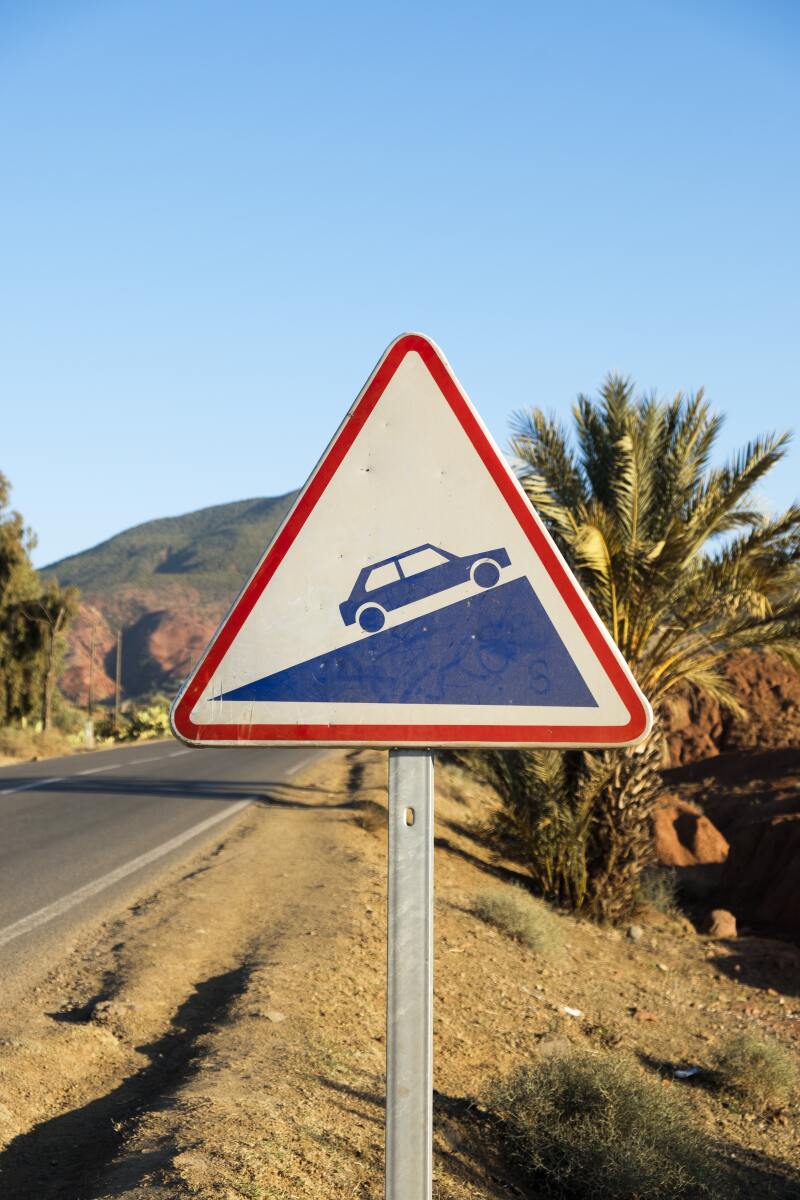
Traveling by bike, Peter and Celia experienced moments many tourists miss.
Photo by Peter Bohler
Not only would we do a new activity in a foreign place, we’d do it on our own. With several weeks, maybe we could avoid seeing all the touristy things in all the touristy ways with all the tourists. Maybe we’d have the time to travel more organically, to meet people and let an adventure unfold. To slow down and get to know the real life that outsiders are often insulated from by tourist infrastructure. We wanted it all, we wanted it now, and we wanted it to happen perfectly. Was that too much to ask? Five days and 150 miles ago, we had picked up our rented bikes and left the narrow alleys of Marrakech’s walled medina. As I dodged mopeds and donkey carts, my panniers weighted with camping equipment, rain gear, a down jacket, sunblock, and a first-aid kit fit for a zombie apocalypse, I wondered to myself—could I really do this?
But the days through the Atlas Mountains had boosted my confidence. As we wended our way around towering jagged hills, I fortified myself with a mantra I said aloud and silently over and over: one foot in front of the other. In my lowest gear and standing up on my bike, I moved at the same pace I might walk, and slowly, slowly, I climbed. Around each switchback there came another, and the smell of new asphalt and exhaust mingled with the dust.
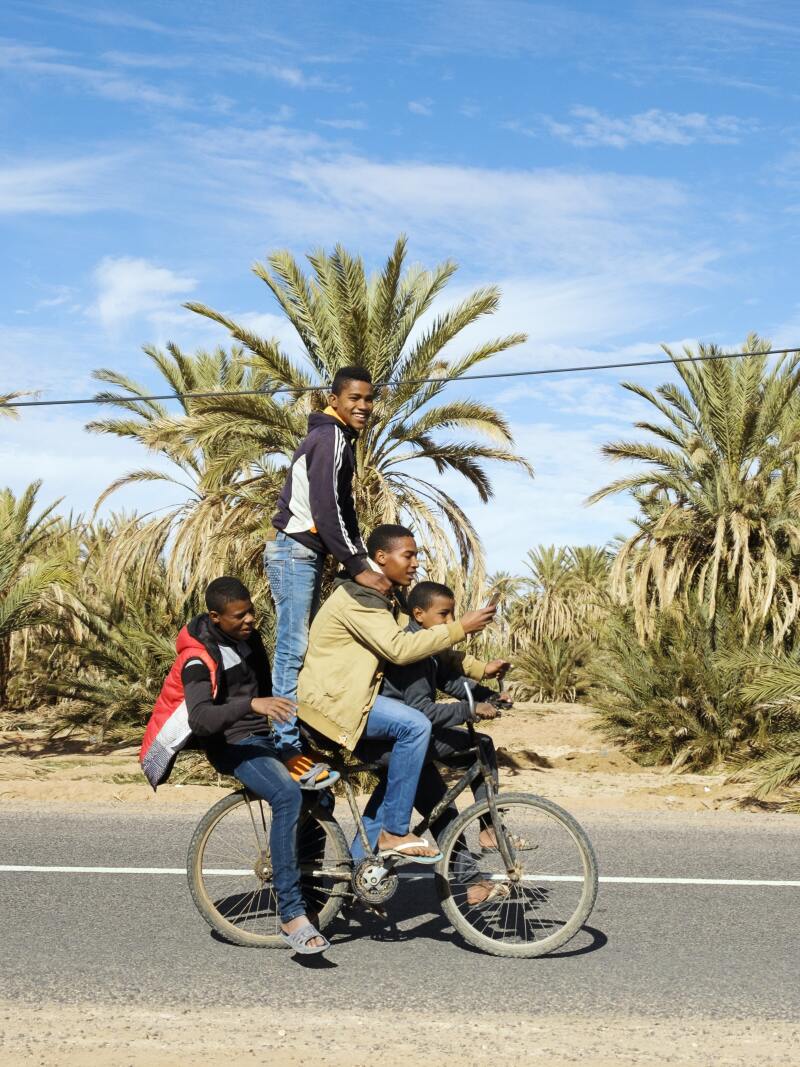
Boys ride on a street in Oulad Edriss, south of Zagora.
Photo by Peter Bohler
We passed mud-brick homes that blended seamlessly with the rock they were built into, their brightly colored doors giving their presence away and offering hints at the life within. Each evening, as the sun set, we’d start thinking about where to sleep. On nights when we could see our breath, we rented cold little rooms from innkeepers who had no other guests. On warmer nights, we set up the tent and relished the freedom of not needing anyone or anything else. On the day we finally made our way over the Tizi-n-Tichka, the highest point we would pass, it took us six hours to creep 30 miles, but the men on the roadside selling geodes to tourists yelled “Bravo! Bravo!” as we passed, and when we summited at sunset, I felt like we had just finished the Tour de France.
As the physical challenge of the trip weighed less heavily on me, a problem with the bikes felt like the next logical demon to battle on our quest. But we didn’t have to face this demon alone. The two strangers that peered over our shoulders, we soon learned, were the café owner, Ismail, and his neighbor, Icho. Ismail was in his early twenties, and though he spoke no English, he radiated a somber kindness. Icho, on the other hand, spoke very good English and moved with a kind of buoyant intensity that inspired confidence.
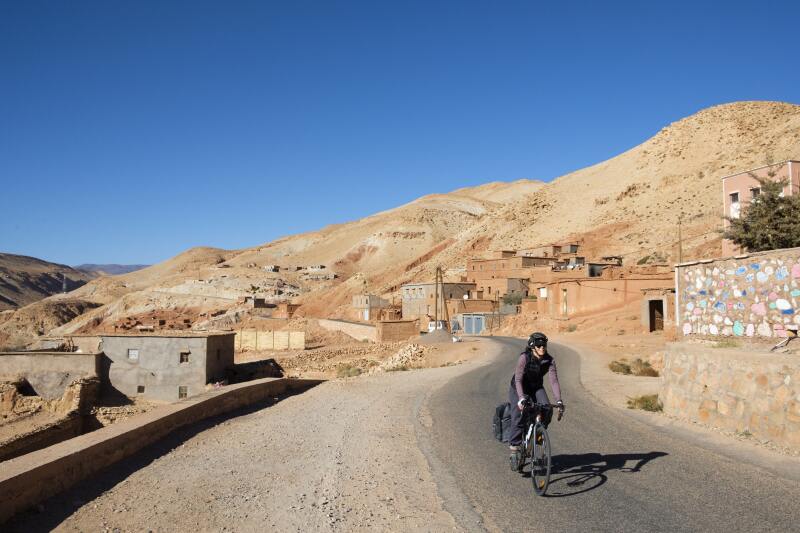
Peter and Celia cycled in a loop of the country starting in Marrakech.
Photo by Peter Bohler
After more than an hour of tinkering, all four of us had bicycle grease on our hands and agreed that Pete needed a new brake pad. Icho told us that our best bet for getting the part was in a big town about 40 miles back. He offered to go with Pete, and within minutes, they were on their way in a passing desert taxi with Pete’s bike strapped to the roof.
Ismail and I walked back to the café. I sat down at a table on the patio and was excited when he joined me. Because of my nonexistent Arabic and very limited French, we determined the best way to communicate was through Google Translate. For several hours we passed our phones back and forth, typing in questions and answers and hoping that the Internet wouldn’t butcher the meanings of our words too terribly. He told me his family was from the nearby hills, that his sister had moved to Canada, his brother to Holland, but since he was the baby, he had stayed nearby to look after his parents. I told him my sister and brother and I all lived in California, but I still wished I saw them more. Our attempts to discuss more complicated topics, such as his efforts to attract business to the café, revealed the limits of our technology. Our conversation might have taken us an hour if we had been speaking directly to one another, but because we were texting, it sustained us through the morning and into the afternoon. The café had no other customers.
It took us six hours to creep 30 miles, but the men on the roadside selling geodes to tourists yelled “Bravo! Bravo!” as we passed, and when we summited at sunset, I felt like we had just finished the Tour de France.
“Want to come to the butcher?” the text in Ismail’s phone asked. I nodded and then left Pete a note at the table, not sure how long this excursion might take. We left the café and walked for two minutes before we reached a squat little structure with a couple of carcasses hanging near the doorway. Entering the fully tiled interior, we found ourselves in a room divided in half by a large chrome table with a few fresh goat heads sitting on one side. Almost as soon as we stepped in, a heavyset man jogged in from behind us, rolled over the countertop, and stood facing us from the other side. Ismail ordered a kilo of lamb from him. On a wooden cutting board, the butcher hacked a lamb carcass into big even cubes, measuring each until the scale with the kilo weight reached equilibrium.
Back at the café we stood in the kitchen chopping onions. We used the only word the other would recognize, respectively, as a stand-in for all other words—Ismail, I said when I finished chopping my pile of onions. Celia, he said when he lifted the top of the tagine to indicate that it was time to add the meat. There was something about the tender way he said my name that made me feel as though I had a true friend all the way over here on the other side of the world. We went back to the sunny patio and waited. Our text marathon had left us both exhausted, and as I sketched in my notebook and he read on his phone, we were content to sit in silence. After a while we added vegetables to the tagine. Then we waited some more. Just as I started to get worried that Pete had been kidnapped, he and Icho returned, having gone on their own odyssey. It had taken the efforts of more than one mechanic, but after six hours, a makeshift brake pad was finally fashioned and the bike was fixed.
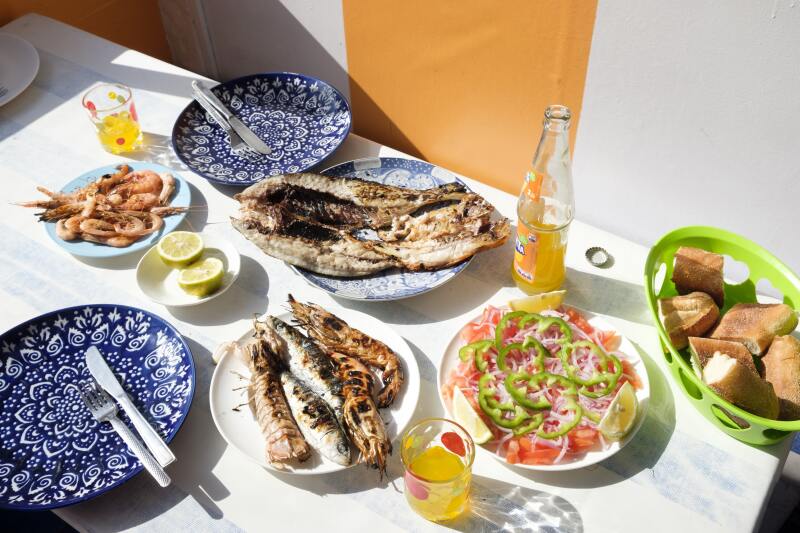
One of the many Moroccoan meals Peter and Celia enjoyed on their 150-mile trip.
Photo by Peter Bohler
The four of us sat down to eat, using pieces of bread to scoop up the stewed lamb and vegetables from the tagine. Icho asked us about our plans. How would we be going into the desert? Days before, we had met our first fellow bike trekker, who was coming from the opposite direction. He had talked glowingly about riding, then pushing, then dragging his bike through the Saharan sand, and about the dunes in the moonlight, how they had looked like a moonscape. When we told Icho we were considering riding out to the dunes on our own, his eyes widened. He did not think this was a good idea. He had heard of people needing to be rescued. People who don’t know the land, he said, should be careful about going out there without people who do. His family was Berber—his grandfather had made his living shepherding livestock across the desert, and Icho had grown up in a little village near the dunes. Some of his family was still there. Would we like to meet his family? Would we like to stay with them, get a sense for this nomadic life and see the dunes?
Before coming to Morocco, I had read a lot about unauthorized “guides” selling trips to tourists that turned out to be less than promised. And in my short time here, particularly in Marrakech, I had become reflexively suspicious of unsolicited human contact. Most people vying for my attention, whether they were giving directions, selling carpets, or simply standing with outstretched arms, seemed to have the same goal: to separate me from my dirhams. The first Arabic word I had picked up was la: “no.” But in this little town, we had needed something, and Icho had come. Could I trust him? If I kept saying no, would we miss out on the adventure we had come here for?
We said yes.
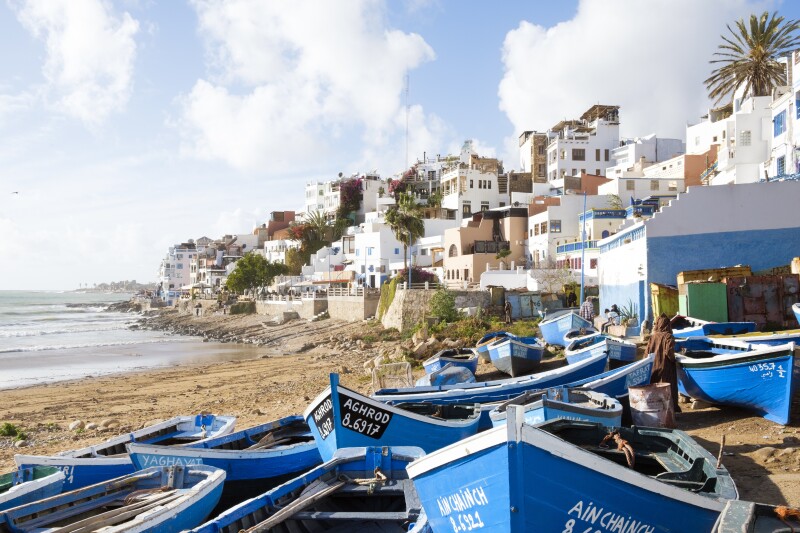
The fishing village of Taghazout has become a popular surfing destination.
Photo by Peter Bohler
We arranged to meet Icho’s brother in a town about 100 miles away in three days’ time. We discussed payment: They would need money for food and transport for us. It was much less expensive than the desert trips that took tourists into villages to meet the locals, and better than that, it was the real thing—a person we had met welcoming us into his family’s home. We happily agreed to pay. It was the least we could do. The next day, our plans laid, we got back on the road. Icho gave us what he called a “Berber GPS,” a map he’d drawn on a paper bag that showed where to get off the main highway and onto a dirt road that went through small villages—the path of the old trading caravans.
We climbed our last series of mountains and went down our last dramatic descents, crossing over into an utterly new landscape: a sea of palm trees. I finally grasped the meaning of a word that had been in my vocabulary since our Morocco research had begun: palmeraie. I had expected some sort of palm oasis, a cluster of trees popping up out of the sand, but what I saw before me were palm groves—highly cultivated agricultural plots with rows of palm trees of every size stretching across an endless expanse of land. The dusty road was shaded by the dense weave of trees planted on either side of it, and the rustling of the trees provided a soundtrack as we biked. Occasionally a farmworker appeared, cutting brush away or walking amongst the grid. Every few miles, we’d pass a small village where people lived in ancient crumbling kasbahs and paid us little mind. Children played soccer in the street, and bright-colored clothing hung on lines.
If I kept saying no, would we miss out on the adventure we had come here for?
The day before we were to meet Icho’s brother, Icho called to inform us that he, too, would be joining us in the desert. I was a little surprised that he would make the trek all the way out here, but when I saw him again, leaning his head out of the window of a desert taxi, his broad smile brought me great comfort. I know him! I exclaimed to myself.
We waited with Icho on the side of the road until a 1970s Renault appeared far off the road in the distance and slowly made its way across the dry, rocky ground to us. Out of it stepped an elegant man in his forties. He wore a bright blue djellaba (a loose hooded robe). He and Icho embraced. Icho introduced us to his brother, Said, and then they got in the car. The bikes were too big to fit, so Pete and I followed in hot pursuit. The ground went from smooth and sandy to hamada⎯barren, stony plateau. The hard-packed land made our handlebars vibrate violently, and the sand made our tires slip and bobble, but we were undeterred. As we followed this little white car into the wide abyss of desert, I felt full of hope and awe and excitement. It was as if I were pedaling toward possibility itself. I think I may have been humming the theme song to Indiana Jones.
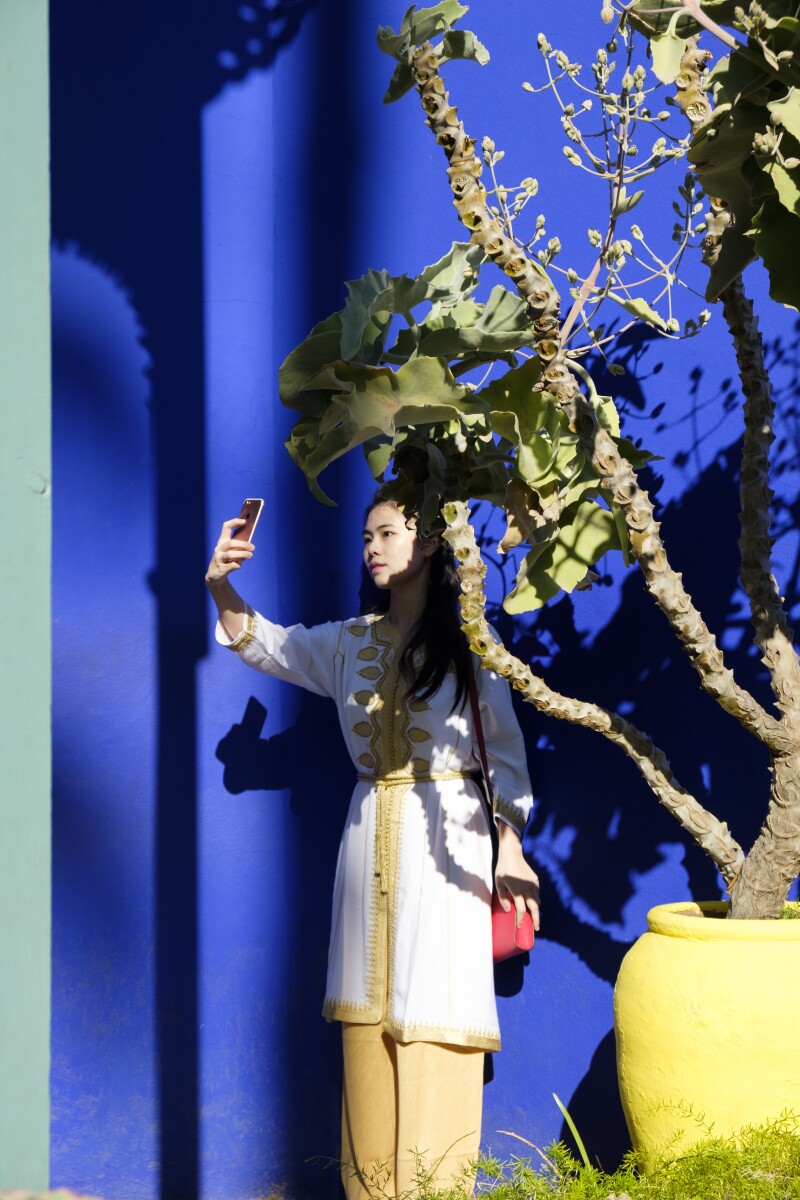
A woman takes a selfie at the new Yves St. Laurent Museum in Marrakech.
Photo by Peter Bohler
As we started to see the small dunes in the distance, I could barely contain myself. Then we saw the nomad camp. A cluster of little huts made of fabric, tarps, and poles anchored into the sand. Wooden benches circled a fire pit, and outside each hut hung a lantern made from a one-gallon plastic water jug. The camp was empty save for us. Said dropped Icho off with us, then drove off. “Where is your brother going?” I asked. “He has to go home to help his wife,” Icho said. “Isn’t this his camp?” I asked. “Yes!” Icho answered harshly, as though the question had disturbed him. I didn’t press him further. Perhaps his brother and his family will come later, I thought.
Pete and I walked out into the small nearby dunes. From there we could see our camp was one of many in the area. As we played in the dunes, many other tourists from nearby camps played too. It grew dark and we could see fires starting at each camp. By the time we got back to ours, there were tourists seated all around it. There was nothing to do but sit with them and accept our fate. We would not be cooking and eating with a family and hearing about their way of life. We would not be having some hard-won experience that money couldn’t buy. We would be tourists with a guide we’d paid to bring us to a place with other tourists. The only difference between us and these tourists was that we didn’t smell like shampoo.
The next day, we left our bikes at camp and rode with Icho in an old Land Rover out to the big dunes. I stared out the window and wondered what exactly was in store for us. Were we even headed to the dunes? I was sure I wouldn’t be seeing Icho’s “brother” again. As the car ricocheted off the rocks, we listened to music. It was like no music I had ever heard. Drums blended with many voices and clapping hands. An electric guitar and bass played in some songs. Others were fast, with auto-tuned women’s voices. The songs adhered to a certain rhythmic logic as they swerved from melodic to discordant and back again. Every song was a surprise. “This music is incredible!” I said to Icho. “I know!” he said excitedly. The bands were all from different parts of the Sahara, he told us. He seemed as thrilled to share these bands as we were to hear them. As we drove on, I became completely entranced, our heads moving simultaneously to the mix of the radio and road vibrations. In this moment of mutual appreciation, my relationship to Icho, my angst about tourism stopped mattering. I didn’t care if he was my guide or my friend, or if I was a gullible tourist or a traveler having an adventure. Perhaps all of these things could be true at once.
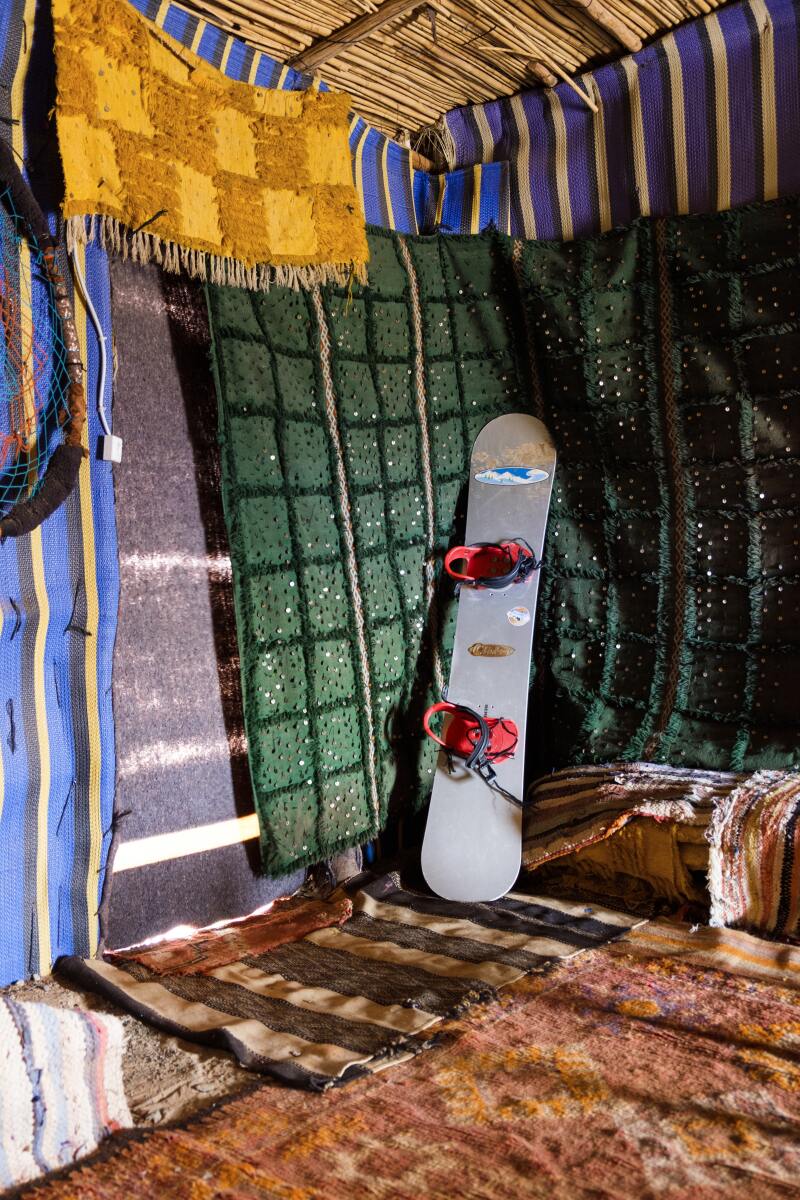
Peter and Celia saw a side of Morocco most tourists miss.
Photo by Peter Bohler
After several hours, we reach the promised land: Erg Chigaga. Or rather, another tourist camp in Erg Chigaga. When the car stopped, I could only leap out and run toward the massive dunes. We buried our feet in the soft warm sand and climbed up the tallest dune we could find. At the top, we looked out at the ocean of dunes stretched before us. Endless. I sat down and felt the sand rush down my back, into my pants. It was inescapably everywhere. I watched the sand break from its perfect formations into new formations that, as soon as they settled, were also perfect. From the top of a dune, I ran down, my legs springing and sinking. I was buoyant and heavy at once. The setting light cast the dunes into incredible shapes, and as it got darker, the shapes continued to evolve. They played tricks on my eyes, convincing me that they defied gravity—a vertical wall of sand became a 30-degree slope once I set foot on it. The bright moon cast new, equally enchanting shadows, and we couldn’t pull ourselves away from the mesmerizing show. We stayed out until our feet became numb from the cold. We found our hut and slept on our sandy mattress a few hours, waking before dawn to go back to the dunes and watch the sun rise over our moonscape.
I didn’t care if he was my guide or my friend, or if I was a gullible tourist or a traveler having an adventure. Perhaps all of these things could be true at once.
In the morning, we drove back across the rocky desert, untethered ourselves from Icho and started pedaling once again. For the next few weeks, we would continue to bike. We biked past argan trees filled with goats eating the fruit high above our heads, we biked along the coast with camels grazing opposite the beach, we biked past groves thick with banana trees. We saw orange, red, and yellow spices piled into two-foot-tall pyramids, and bright tile work with its lacelike geometry, incomprehensible in its painstaking patterning. We ate fresh seafood at piers and fresh crepes from stands. Toward the end of the trip, camped along the coastline, as I listened to rain drumming down on the tent, I thought back to the camouflaged homes built into the Atlas Mountains, to chopping onions with Ismail, to following the little white car through the desert, to listening to music as my head rattled against a dusty car window. I thought about the difference between seeing a place and knowing it, and about all the mysteries that await as you move from one toward the other.
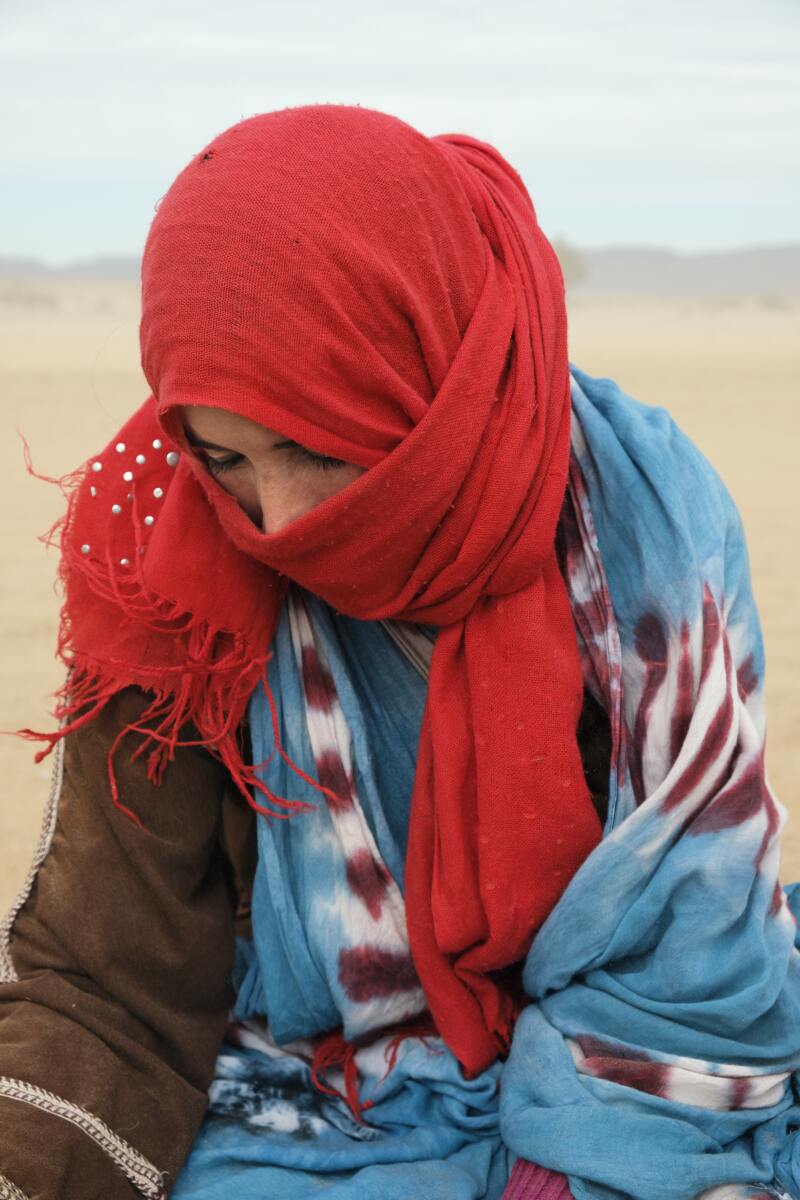
“I thought about the difference between seeing a place and knowing it, and about all the mysteries that await as you move from one toward the other.”
Photo by Peter Bohler
>>Next: A Michelin-Starred Chef and Farmer Share the Best Parts About Sonoma

